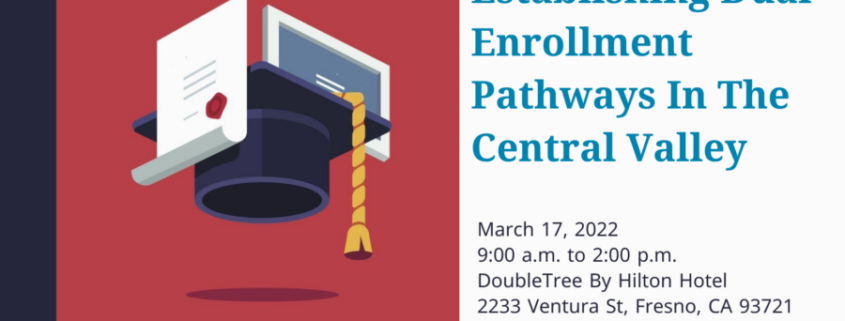CVHEC Dual Enrollment Convening set for March 17 in Fresno
The “Establishing Dual Enrollment Pathways in the Central Valley” convening Thursday, March 17, will bring more than 150 secondary and postsecondary educators together in person for the first time since the pandemic shutdown to address challenges and barriers to dual enrollment success.
Presented by the Central Valley Higher Education Consortium, the convening will be from 9 a.m. to 2 p.m. at the DoubleTree By Hilton Hotel in downtown Fresno.
Registration to participate is now open at: https://bit.ly/DEpathwaysCV (the hotel link is https://bit.ly/DoubleTreeFresno).
This second convening will continue the work started on March 5, 2020 – two weeks before the pandemic shutdown – which resulted in several initiatives that have enhanced the delivery of dual enrollment in the region:
- Improvements in the CCCApply application process to the California Community College system.
- The Dual Enrollment Upskilling Teachers Master’s Program that provides access to state funding through the Fresno K-16 Collaborative providing funds for high school English and math teachers to earn their master’s degrees.
“This unique event — intersegmental collaboration at a regional level — will be highly interactive and will engage audience members with panel presenters from valley colleges and high schools including practitioners and student success stories,” said Dr. Benjamín T. Durán, CVHEC executive director.
This renewed localized promotion of dual enrollment began in Spring 2019 when Central Valley community college leaders approached CVHEC to provide convening assistance surrounding dual enrollment, a strategy that allows secondary school students to earn college credits before their high school graduation.
As a result of the discussions in these early gatherings, the Central Valley Dual Enrollment for Equity and Prosperity (CVDEEP) Task Force was formed with about 60 community college and K-12 educational leaders who deliver dual enrollment services valley-wide.
“These educators endeavor purposefully and strategically in addressing the complexity of dual enrollment to spotlight both challenges and best practices for colleges and high schools in the nine-county CVHEC region,” Durán said.
In June 2020, CVHEC released a 16-page report, “Dual Enrollment in the Central Valley, Working Toward a Unified Approach for Equity and Prosperity;” by former CVHEC Strategies Lead Virginia Madrid Salazar, Esq., that highlights this work and provides a blueprint to strengthen dual enrollment delivery in the Central Valley. (Also, see her blog in this issue: https://bit.ly/CVHECblog-DualEnrollment021822).
Check for updates and event follow-up at the CVDEEP Convening Website
SEE: CVHEC report, “Dual Enrollment in the Central Valley, Working Toward a Unified Approach for Equity and Prosperity” and press release).
- The 2020 CVDEEP Convening
- Updated CVDEEP press release (March 14, 2022)
BACKGROUND
In 2016, a new dual enrollment option was introduced through Assembly Bill (AB) 288, amending Education Code (EC) 76004, and creating the College and Career Access Pathways (CCAP). This legislation enabled more high school students to take college courses taught by college professors on their high school campuses. California AB 30, signed by Governor Newsom in October 2019, expands and protects dual enrollment through 2027.
CVHEC media contact: Tom Uribes • tom@uribes.com • 559.348.3278



